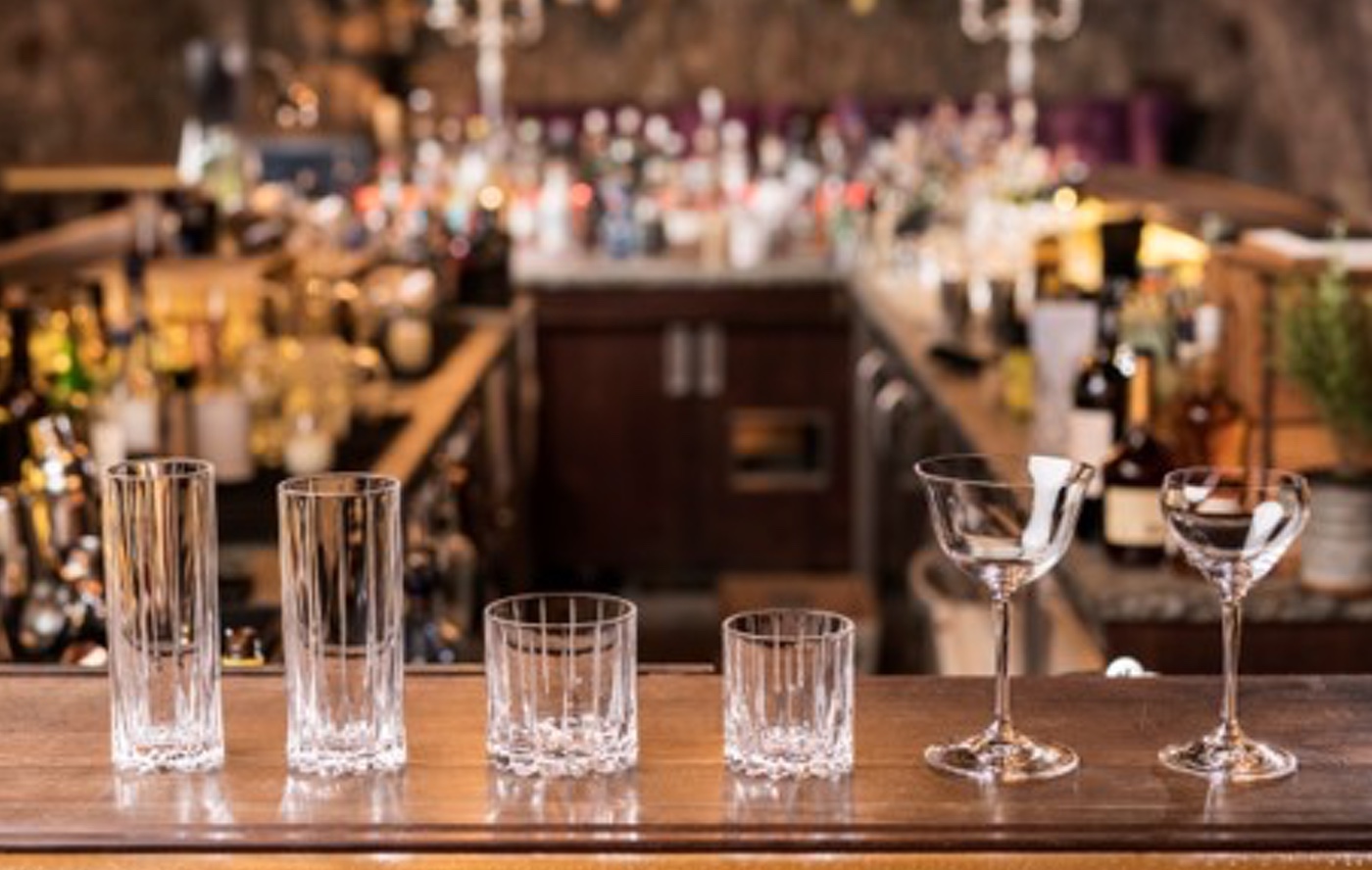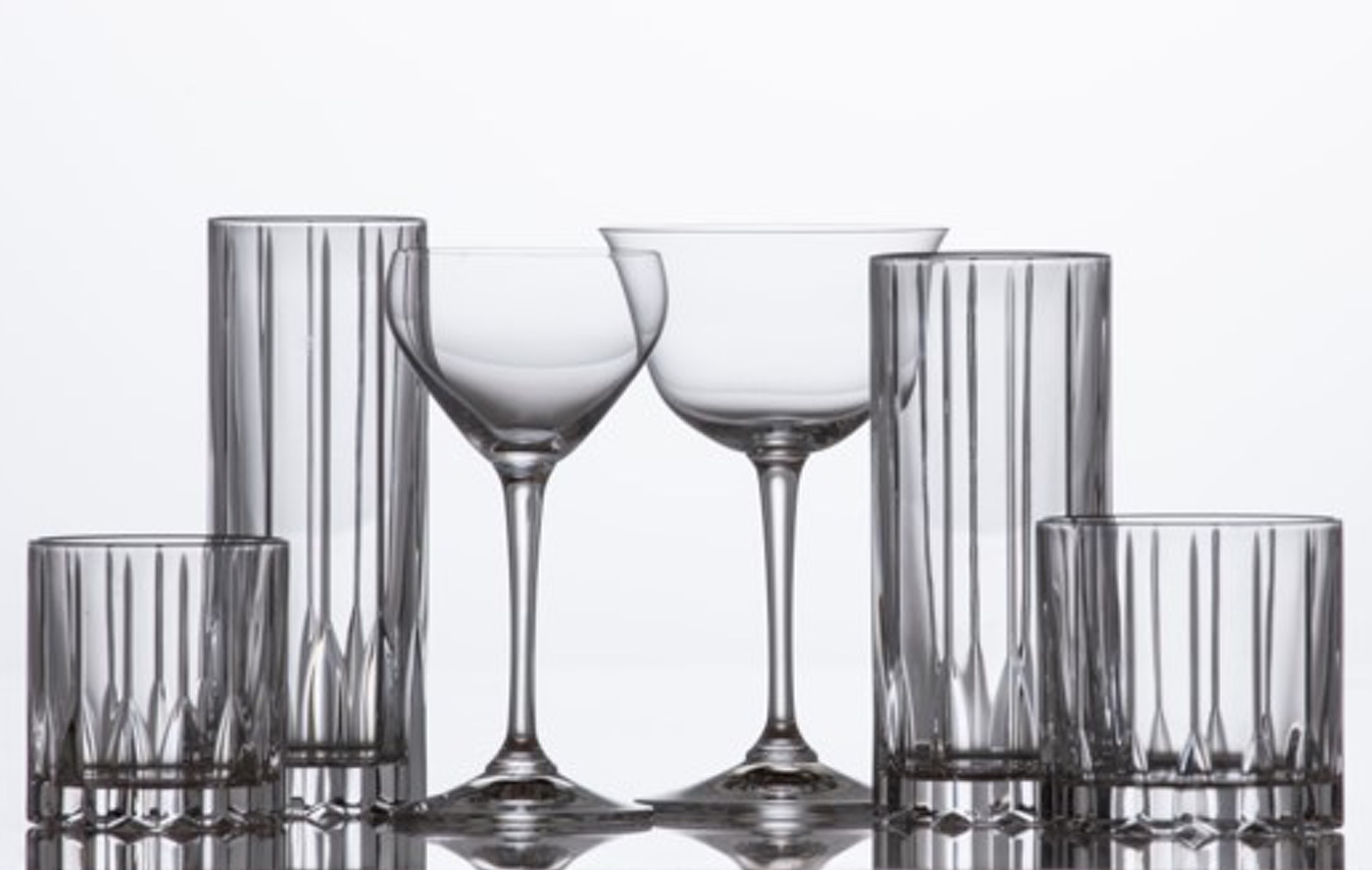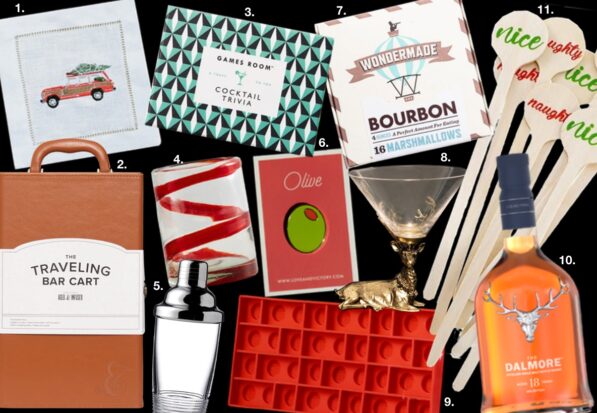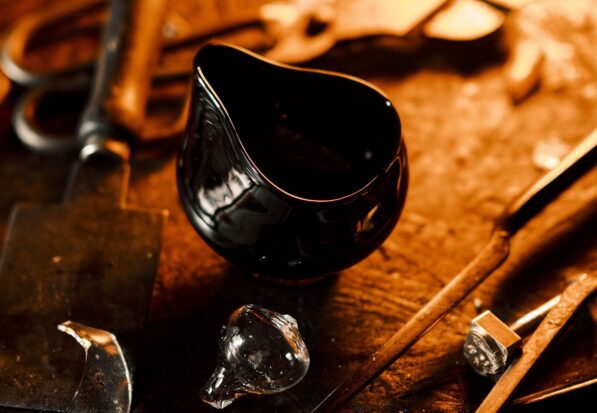Everyone’s been to a party where there wasn’t enough of the right glassware for the cocktails being made, but imagine having a world-wide craft cocktail renaissance where the ice didn’t quite fit the glass, and the highball glasses were so big they were diluting the drinks.
What? You don’t need to imagine it? Oh, that’s right, we were all there.
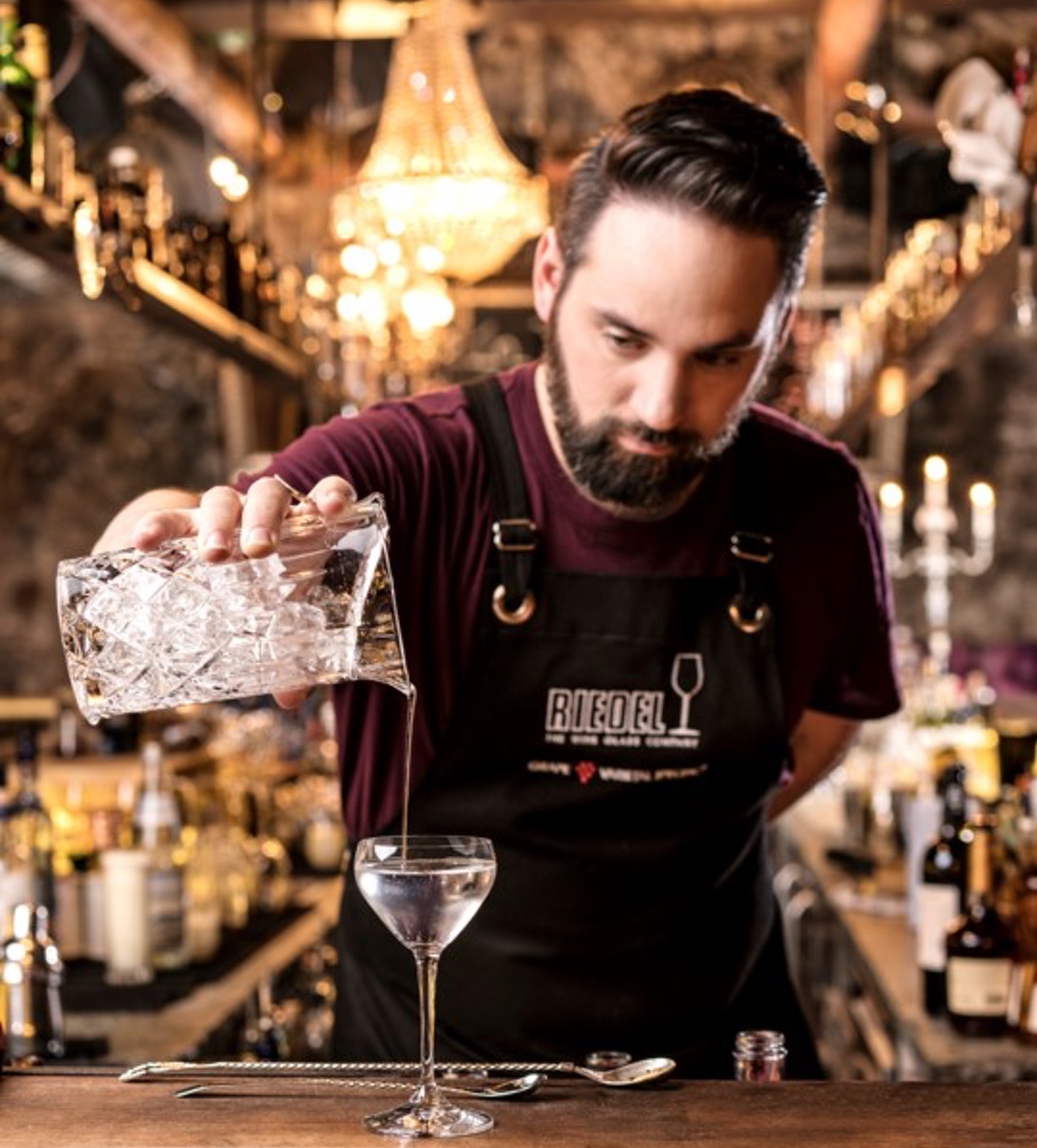 PIN IT
PIN ITZane Harris with the Nick 7 Nora glass
The problem
For all the innovation, found recipes, rediscovered liqueurs and little known techniques, the craft cocktail movement suffered from one relatively big problem. It didn’t have the right glassware.
Everyone complained about it, but no-one really knew what to do to change the situation. A lot of the glassware that was available were designs that had been around since the ‘70s and ‘80s (a time not widely known for its cocktail prowess). And a lot of the old cocktail glass designs had been lost in time.
“Eventually the industry just stopped complaining, shrugged their shoulders and simply adjusted their drinks to fit the existing glassware, rather than the other way around,” said Zane Harris
“All of this stuff was accumulating in my head; the size, the shape, the functionality of the glassware that everyone wanted. And I swore that if I ever found myself in a room with a glassware maker, I would have to speak up.
The opportunity
And a couple of years ago, Harris got the chance to do just that.
Of all places, Harris found himself at a 3-day seminar in Arizona with Georg Riedel, the Austrian glassmaker and businessman who is the tenth-generation owner of Riedel Glassware.
The one thing over which we never had control, was who the hell was making our glassware.
“I was sitting in the room, listening to Riedel speak, but all the while, drawing glass designs on napkins and making rudimentary 3D models on my computer. I was so focused that I didn’t notice that Georg was behind me. He knocked on the table and said: “Sir if you are not here to pay attention, get the hell out of my room.”
“So, I moved my laptop, and the 3-D Nick and Nora glass was slowly turning. He saw all of these napkins with sketches, and I said to him we need to talk at lunch. He looked down at what I’d been doing, then looked at me, and he said yes, he’d meet me at lunch.”
And with that, started a two-year journey that would take Harris and the Riedel company on a deep dive into what bartenders and bars needed from their glassware to compliment the cocktails and drinks they were not only creating but also recreating.
“There was so much we had control over,” said Harris. “We could meet the distillers, meet the blenders and know they are doing the sustainable thing. Then it moved over to ice, and we started to make and hand-cut our own ice.
“The one thing over which we never had control was who the hell was making our glassware. With so much working so well in the industry, the disadvantage of the glassware was something that everyone complained about, but no-one really knew how to address.”
Coming from a hospitality family, Harris was part of the craft cocktail movement in Seattle from the start. Beginning with running the 6-seater bar at the back of his parent’s restaurant, he went on to open his own bar, the Rob Roy. Simultaneously, he became a spirit specialist, as well as a bar and hospitality consultant.
“I took all this information that I had heard over the last 15 – 20 years with everyone complaining and I tried to distil it down,” he said. “As far as I was concerned, the worst that could happen was that I would have to go back and tell everyone I tried. But instead, Georg said “I’m in, 100%. Just get it off the cocktail napkins and into a real presentation by next week, then we can get started.”
The solution
So Harris worked up his designs, which the company made into prototypes. Harris then took these around to everyone he could find; restaurant bars, high-volume bars, high-end cocktail bars and home mixologists.
“The company gave me the prototypes in a hard case, surrounded by cut out foam. The glasses were handmade and worth about $10,000 apiece, and I was hugging that hard case for dear life, as I went around New York on the subway.
“We didn’t just want people to say that they were pretty or beautiful, I didn’t want to hear that. I wanted the guys to tear them apart. I wanted them to think about how these glass for making drinks, think about the ice, think about them in their dishwashers, think about everything.
“I needed feedback on every aspect; how they worked in every situation and what we needed to do to make them better. As I saw it, this was probably our only opportunity to get it right.”
The issues
Aside from the look, feel and size of the glasses, issues like tempering needed to be addressed. Were the glasses durable enough to go from hot dishwashers to cold chillers? Could some of the glasses be stacked or only nested where they might stick together when they cooled down? Even issues about the strength of the glass where it was cross-hatched were questioned.
“The star brushed pattern on the bottom of the glasses was one innovation. We needing to take the bulk out of the bottom of the glass in order for it to cool down properly. But then that led me to a really fun design element, which allowed me to stack the glasses. They lock in like cubes; that way, you don’t have to nest the glasses. I wanted to have stackability but without having them nest inside of each other.
So what is next? Well, Harris is talking about redesigning the mixing glass to give it a straighter edge and maybe creating a larger Nick & Nora style glass.
“The glassware is great; I am very proud of it,” he said. “But really what I am most proud of is that this is the first time a glassware company has ever listened to the cocktail industry, the booze industry and the spirit industry – and they didn’t argue at all.”
The result
Neat Glass
The whole point of the redesign of the neat glass was to ensure that consumers felt they were getting value for money.
“In a normal rocks glass that is meant to hold an ice cube to displace the alcohol, if I poured 2 ounces or 60ml, it looks like I am pouring almost nothing in the glass,” explained Harris. ” To my guests, their perception is that I am pulling the wool over their eyes.
“If you actually put your two fingers against the side of our new neat glass and pour 2 ounces in there, it works. I wanted to bring that back. I wanted to have a glass that I could say a two-finger pour is actually 2 ounces. So that was really important.
Rocks Glass
The straight sides of the rocks glass are one of its most significant features, so there is no need to chip away at the ice to make the cubes fit all the way down. The other major win is that the whole glass is triple tempered to ensure durability.
“Most glassware is only tempered on the top third to the lip because that is where it is going to chip or crack, but tempered glass cools off at a different rate than untempered glass.
“I sent a drunken email saying that the glass needed to be tempered from top to bottom,” continued Harris, “and then the crazy German engineer went ahead and built a machine to do that. The result is a much more durable glass.
Highball Glass
While most highball glass on the market push towards being 16 ounces, Harris’s issue was that if you were making a simple whiskey, soda water with a lemon twist, the amount of soda water you would need to add to fill the glass would overdilute the whiskey.
“I had to shrink it down to 11 ounces,” said Harris. “Eleven ounces with the right height for the ice means that you don’t have to add a tonne of mixer to fill up the glass.
“Also those have the 2-ounce pour lines in it too, so if you are making highballs you can free pour right into the glass without having to use a jigger. A lot of old school customers like to see the free pour, they hate jiggers.
Fizz Glass
While for many, a fizz glass and a highball are often used interchangeably, Harris points out that traditionally a fizz glass is meant to be a full two ounces smaller than a highball glass.
“So a Ramos Gin Fizz for example, which is two gin, ¾ lemon, ¾ simple syrup, one cream, orange flower water and soda water. All of that is a very specific ratio you have to hit it in order to be able to make the soufflé that comes out of the top. With a large glass, you were forced to add more and more soda water that would make it would fall over the sides and get too diluted.
“I needed to make something that was narrower and taller than the highball, yet with less volume and completely straight-sided which was a big engineering feat,” continued Harris. “as well as tall, narrow and straight, they couldn’t be super expensive, and they also had to be seamless. Difficult, but totally worth it.”
Nick & Nora
The glass is named after the two main characters from (1934) The Thin Man movies. They were kind of like the first celebrity couple and their fame included the glassware from which they drank.
“I literally copied the shape from the movie and then I tweaked it to fit the aesthetics of a longer stem, a more proportionate base, with a more delicate lip,” said Harris.
“You might think the Nick & Nora should have straight sides, but that is not the shape of the glass from the films. That original glass has a curved edge, and we now have the technology to be able to produce that.”
Sour Glass
The Sour glass was designed to do the opposite of the Nick & Nora glass. So rather than forcing you to tilt your head back, as you do with the Nick & Nora to deliver the high proof alcohol of a Martini or a Manhattan, the sour needed to deliver the drink to the tip of your tongue.
“It is a very classically designed glass with that tulip-shaped lip that goes out, ”said Harris. “I wanted to make it wider while ensuring the base was heavier than the top. To ensure it doesn’t get messy, I wanted a nice vessel into which people could put those aromatics like dried lavender or black pepper or aromatic bitters
“Anybody who uses egg white knows that if you use a narrow glass with an egg white, it smells like wet dog. It’s disgusting. With this glass you don’t get that anymore because those smells go this way, while the aromatics go this way – it’s not being funnelled up.”







